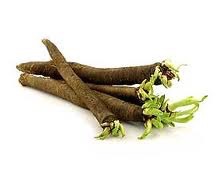scorzonera hispanica, known as scorzonera, also called black salsify, black oyster plant, and viper’s grass. Originating in the Mediterranean area, scorzonera and salsify were foraged and used by the ancient Romans as well as the Greeks. People never thought to cultivate them until sometime around the 1500s. They were then used for ornamental, medicinal, and culinary purposes. In the Middle Ages, scorzonera was considered a powerful tonic and snakebite cure — hence the name viper’s grass. Salsify came to America in the 1700s and was at one time a popular root crop. When modern refrigeration and shipping techniques made the storage of perishable foods easy, salsify fell out of favor. Scorzonera, or black salsify, has a uniformly straight root that’s covered with a charcoal or brown-gray, somewhat slippery skin. It usually grows longer, straighter, and smoother than salsify. The leaves look like a clump of coarse grass. With some varieties, the leaves are “cut and come again” greens that make a fresh addition to salads.Salsify, or white salsify, has a root about the size of a large carrot. Bumpy like a parsnip, the salsify root has dirty-beige skin. The root looks a bit wilder than scorzonera and the leaves also look like a clump of grass. (Indeed, many people have weeded out young salsify or scorzonera and then wondered why their crop didn’t germinate!) Both plants are biennials.Scorzonera has an oyster-like taste. Salsify’s flavor has been described as a cross between oysters and asparagus. Some people complain that salsify is blander, more fibrous, and harder to peel than scorzonera. Others remain loyal to salsify.


these are very interesting!………i tracked some down through the seed savers network for one of my chain de rottiseur dinners…..all the ingredients that i used were rare and unusual and the guests had to guess what they were eating…..only at the end were they given the menu and after my short (very) spiel did they know what they had eaten…..i shall elaborate on the rest of the ingredients another time…..